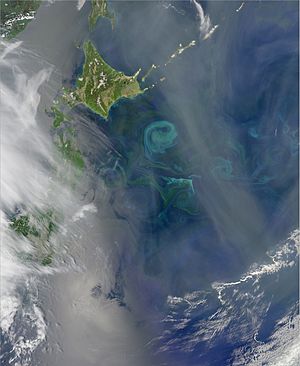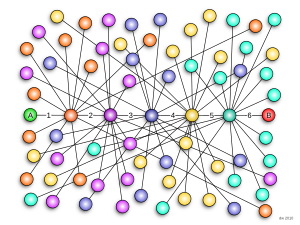Peter Killworth facts for kids
Quick facts for kids
Peter Killworth
|
|
|---|---|
| Born |
Peter D. Killworth
27 March 1946 |
| Died | 28 January 2008 (aged 61) |
| Nationality | British |
| Education | Trinity College, Cambridge (1969) Trinity College, Cambridge (1972) PhD |
| Occupation | Scientist, writer, pioneering author, professor |
| Known for | Oceanography Social Network theory |
Professor Peter D. Killworth (March 27, 1946 – January 28, 2008) was a British scientist. He was famous for his work on oceanography, which is the study of oceans. He also studied social networks, looking at how people connect with each other.
Peter Killworth was a very active writer. He published over 160 scientific papers during his career. He was also known for creating early text-based computer games in the 1980s. Peter Killworth passed away in 2008 from a serious illness called motor neurone disease.
Contents
Exploring the Oceans

A big part of Peter Killworth's career was spent as an oceanographer. He used applied mathematics, which is like using math to solve real-world problems, to understand how oceans work. He was interested in many things about the physical ocean. This included studying ice, open water areas in ice (called polynyas), and large waves that move through the ocean (known as Rossby waves). He also studied how ocean currents become unstable and form swirling patterns called eddies.
He earned his PhD in 1972 from Trinity College at Cambridge University. His research focused on using numbers to study ocean movements. After spending a year doing research in California, he returned to Cambridge. He worked with his former PhD supervisor, Adrian Gill, for 12 years at the Department of Applied Mathematics and Theoretical Physics. During this time, he also taught at the Woods Hole Oceanographic Institution in the US.
In 1985, he moved to Oxford to join the Robert Hooke Institute. He also became a Research Fellow at Wolfson College and later at St Cross College. In Oxford, he built and led a research team. This team was at the forefront of using computer models to study the ocean. When the Institute closed, he moved to Southampton in 1995. There, he built another team at the Southampton Oceanography Centre. This center is now called the National Oceanography Centre, Southampton. His new team focused on understanding ocean processes through modeling.
During these years, he started a journal called Ocean Modelling. This journal quickly became one of the most important oceanography journals. In 2005, it had the highest impact factor of any physical oceanography journal. This means its articles were cited very often by other scientists.
Killworth received several awards for his work. In 2000, he became a Fellow of the American Geophysical Union. He received the Fridtjof Nansen Medal from the European Geophysical Society in 2002. In 2008, he was given the Stommel Research Medal from the American Meteorological Society. This award was for his many important contributions to ocean modeling and ocean theory. After he passed away in 2008, the UK National Oceanography Centre created the Peter Killworth Memorial Fund. This fund gives an annual award to students to support their research and help them grow as scientists. It honors Peter's dedication to helping new scientists.
How People Connect: Social Networks
Killworth was also known for his work on social networks. He used mathematical models to understand how people interact and connect. His work in this area started in 1972. He met an American anthropologist named H. Russell Bernard while they were both working in California. Bernard was studying how different people on an oceanographic ship knew each other.
Killworth suggested using a special computer algorithm to help with this research. Over the next few years, they worked a lot on the idea of a "small world". They looked at how many people the average person thinks they know. They also studied how many people the average person really knows.
Killworth became more interested in using social networks to answer tough questions. These were questions where people might not give honest answers on surveys. Or, there might not be direct information available. He called these "apparently uncountable populations." He stressed how important this kind of research was in the real world. He said that before we spend money on a social problem, we need to know how big the problem is. He explained that it might not matter to scientists if the average American knows 290 people or 2,900. But it matters a lot if we can figure out if groups like the homeless are growing or shrinking.
One important result of this work was a challenge to Dunbar's number. Dunbar's number is a theory that suggests there's a limit to how many stable social relationships a person can have. These are relationships where you know who each person is and how they relate to others. Dunbar's number wasn't based on directly observing how many relationships people have today.
Killworth and his team did several studies in the United States. They found that the average number of connections a person has was about 290. This was roughly double Dunbar's estimate. This wasn't just a guess; it was a repeated finding from their studies. In 1997, Killworth and Bernard were the main speakers at a big meeting for social network researchers. They presented all their work on this topic.
While best known for his work with Bernard, Killworth also worked with other social network researchers. These included Chris McCarty, Gene Shelley, and Gene Johnsen.
Creating Computer Games
In the late 1970s and early 1980s, the Department of Applied Mathematics and Theoretical Physics in Cambridge was a hub for early interactive fiction games in the UK. These were text-based adventure games. Peter Killworth wrote a groundbreaking computer game called Brand X with another mathematician, Jonathan Mestel.
The software part of Acorn Computers was located very close to his department. Soon, Acornsoft bought the rights to Brand X. It was then released commercially for the BBC Micro computer as Philosopher's Quest. Other games followed, including Castle of Riddles, Countdown to Doom, Return to Doom, and Last Days of Doom. These later games were released through a company called Topologika. Killworth described these games as "puzzlefests." He said you could die in many (hopefully funny) ways, but an "undo" feature would fix that. He also noted that it was very easy to get stuck in the games. In 1984, Killworth published a book about how to write and understand text adventure games.
Killworth also worked on other computer programs. He helped develop a popular program called Tau, which created graphs. He also contributed to the design of the EasiWriter and TechWriter packages. These were software programs published by Icon Technology.
Other Cool Stuff
Peter Killworth was also a very enthusiastic amateur magician. He was a member of the Cambridge University Pentacle Club for many years. In 1984, he created a computer program called Paul Daniels' Magic Show. This was released under the Acornsoft Graphics brand for the BBC Micro computer. It allowed users to perform various magic illusions using their early home computers.


